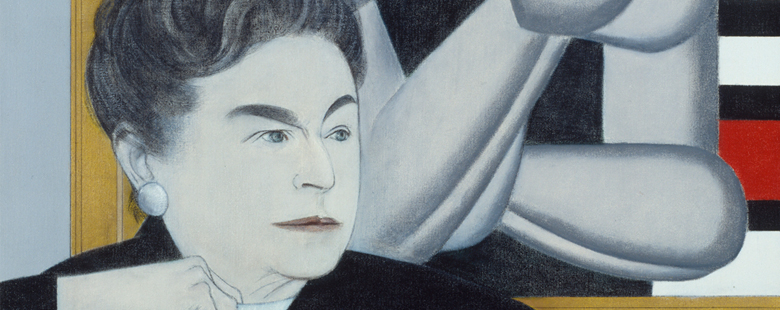Katharine Kuh
Below Robert Eskridge, Executive Director of Education at the Art Institute of Chicago, addresses the influential interpretative work of pioneering art historian, curator, and educator Katharine Kuh.
Questioning the Present/Repossessing the Past
In 1955, near the end of his tenure as director of the Art Institute of Chicago, Daniel Catton Rich argued that education “should be made the core, rather than the fringe of a museum program.” He knew of what he spoke. To an unprecedented degree he had accomplished just that by initiating scholarly lectures and symposia related to major exhibitions, by using the mass media of radio and television to broaden the museum’s reach, and even by organizing a national conference in 1944 titled “The Future of the Art Museum as an Educational Institution.”
Arguably Rich’s most singular act on behalf of museum education was the 1939 establishment of the Gallery of Art Interpretation, the “first permanent interpretive space for adults established by an American museum” whose function was “to give both children and adults a clearer understanding of different artists and their various means of artistic expression.” With his appointment of Katharine Kuh (1904–1994) in 1943 as curator of the Gallery, Rich unleashed a formidable talent who inaugurated a series of interpretive exhibitions over the next eleven years that would prove to be revolutionary and to resonate up until to the present day, not only at the Art Institute of Chicago but across the museum field as well.
After enjoining architect Ludwig Mies van der Rohe to redesign the Gallery of Art Interpretation into a spare, flexible, modern space, Kuh organized eleven exhibitions there between 1944 and 1952. “Here we tried out various experiments, hoping to explain art in visual rather than verbal terms,” she wrote in her autobiography. Exhibitions in this interpretive laboratory were thematic (Explaining Abstract Art; From Nature to Art; How Real Is Realism?), monographic (Who Is Posada?; Close-Up of Tintoretto), or related to a major exhibition (Constable to Turner: The Road to Impressionism). Her overlapping duties as an educator and as the museum’s first curator of modern painting and sculpture led her to relinquish the original function of the Gallery, which was revived a decade later as the Hammerman Gallery in the Art Institute’s Junior Museum and its subsequent Kraft Education Center.
Prior to her hire at the Art Institue of Chicago, Katharine Kuh had founded the Katharine Kuh Gallery (1935–1942), the first commercial art gallery in Chicago to show the work of such avant-garde artists as Josef Albers, Ansel Adams, Alexander Archipenko, Stuart Davis, Vasily Kandinsky, Paul Klee, Joan Miró, Isamu Noguchi, and Edward Weston. She also conducted classes on modern art at the Gallery. Once at the Art Institute of Chicago, she acquired several iconic works by these and other modern artists. Throughout her career as an art dealer, curator, art critic for the Saturday Review, and author of several books on art, including popular books on art appreciation, she remained first and foremost an art educator: “My life has been a long vista dominated by the fecundity of art,” she wrote in the introduction of her autobiography. “Seeing is the result of intuition and knowledge, of concentration and dream, of strong emotional reaction, and, not least, flexibility…. We need what endures from the past to understand discoveries of the present…to sort them out cogently demands perspective.” In providing that perspective to thousands of visitors in the Gallery of Art Interpretation, Katharine Kuh was indeed a profound pioneer in museum education.
Image credits: Will Barnet American, born 1911, Homage to Leger with K. K. [Katherine Kuh], 1982, Oil on canvas, 106.7 x 106.7 cm (42 x 42 in.), Gift of Mr. and Mrs. William Y. Hutchinson, 2002.634, The Art Institute of Chicago. Photography © The Art Institute of Chicago.

